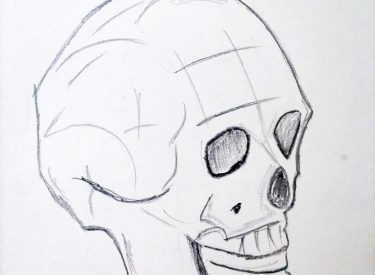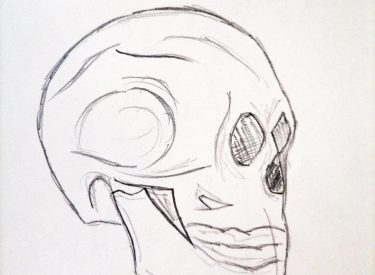The creation of a pencil skull drawing that is authentic in appearance necessitates the observation of the skull’s proportions, which necessitates a substantial amount of time.
Correct coloring and shading techniques are important, but so are double-checking the proportions. It is critical that the eye sockets, nose, and mouth be drawn with the same size and shape. For finer details, use a darker pencil.
Once the sketch is finished, visual flaws, such as squint eyes and a smile, may be added to enhance the overall realism.
The initial phase of creating a realistic pencil skull drawing involves sketching the skull’s outline. With a hard pencil, start by drawing the skull’s shape in the center.
Then, using symmetrical triangles that meet at the top of the teeth, draw the cheek lines. Continue with the oval construction line, forming a square-like shape with bends and curves, which constitute the jawline.
When it comes to drawing realistic skulls, sketching basic shapes is crucial. After completing the sketch, refining it with contour lines is crucial.
These lines will emphasize the skull’s characteristics and enhance its photorealism. It is essential to adhere to certain guidelines when drawing these lines, such as those for the direction and height of the nasal cavity.
Following a few simple guidelines will help create a convincing skull drawing, which can be utilized in the next stage of the process.
After deliberating on how to initiate your drawing, it may prove wise to begin by sketching the skeletal framework. Before proceeding to the actual portrayal, make several attempts at drafting the rudimentary skull.
Next, refine your design with contour lines to accentuate its nuances. Ensuring compliance with these parameters when tracing a faithful skeleton will greatly benefit your final work.
Should your draft fail to meet your standards, consult a reference photo to facilitate improvement. Following this, employ these references to devise your own cranial anatomy.
Once the preliminary sketch of the skull is done, proceed to define its perimeter. This involves delineating the skull’s contours, including those of the eyes and nose.
Elaborate on these features with intricate details of the teeth and eye sockets. You could incorporate fanciful details into the design as well, depending on your preferences.
Afterward, commence shading the skull, with the darker areas made darker, and the lighter ones made lighter.
In the process of constructing a realistic skull, it would be beneficial to note the key elements of the cranium.
The facial characteristics of the skull are an indispensable facet of your masterpiece, requiring exacting attention. The portrait should be readily recognizable, bearing a resemblance to an authentic human skull.
out ample time to complete this task, enabling you to experiment with diverse options, thus lending greater appeal to the finished product.
To commence the production of a verisimilar sketch of a skull, one must begin to shade it.
To attain such an outcome, one should initiate with a horizontal line of an identical width to the bottom of the nose. Then, proceed to include the ocular organs and other aspects of the face. Subsequently, attach the integumentary system.
In case one is perplexed about the intricacies, one could procure a genuine human skull from an auction website and employ it as a guide.
In order to create a convincing drawing of a skull, the fundamental aspect is to grasp the structure of the skull.
For instance, given the intricate nature of the skull, it is prudent to commence with a basic circular shape. It is vital to draw the nose and its orifice in the appropriate proportions.
The nasal cavity should be comparatively box-shaped at the bottom than the top. The line parallel to the ground, which outlines the midpoint of the cranium, ought to be twice the width of the skull.
Conclusion: Realistic Pencil Skull Drawing
In conclusion, to fabricate a genuine illustration of a skull with a pencil, one ought to commence with sketching the major constituents of the cranium.
The eyes are the most imperative part of a skull; thus, one should make them as distinct as feasible. Then, append the traits of the skull, such as the hair and facial expressions.
The ultimate stage is to include the intricate details of the visage. During the process of drawing the cranium, the orbits, and the facial structure, one should consider the angles and bones to create a naturalistic and believable rendering.
Check out:
10 Best Realistic Ghost Doodle Pencil Drawing
10 Best Easy Flowers Pencil Drawing
All gold gradient background images
All sunset gradient background images
All Spotify gradient background images
All Instagram gradient images background
All blue shades backgrounds images
All pink shades background images











